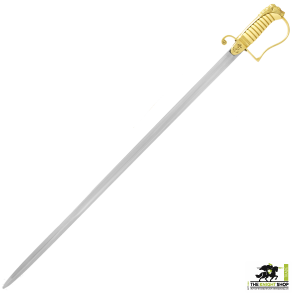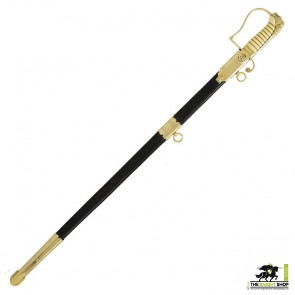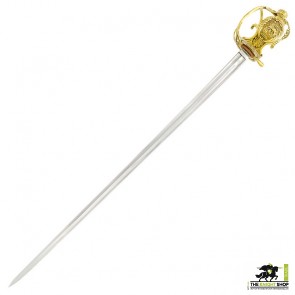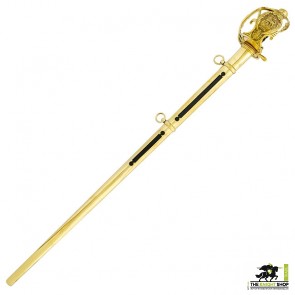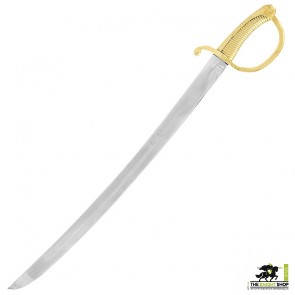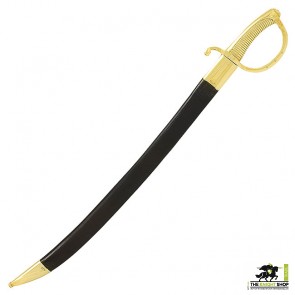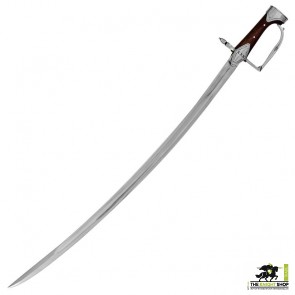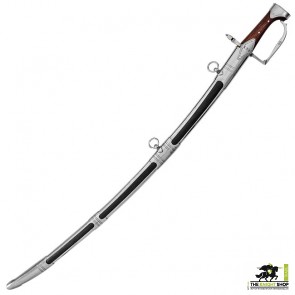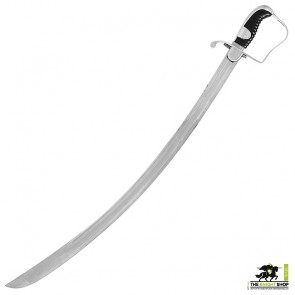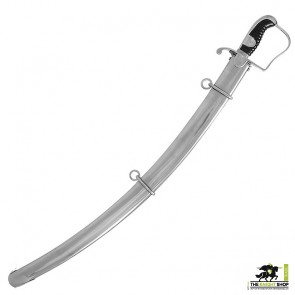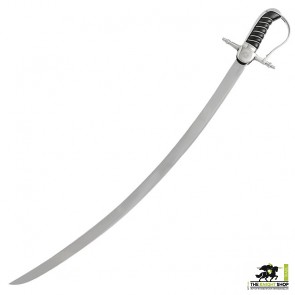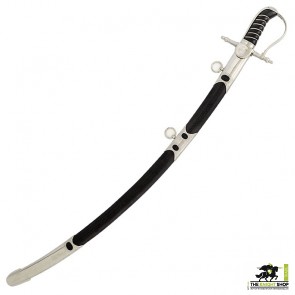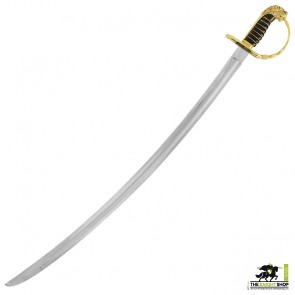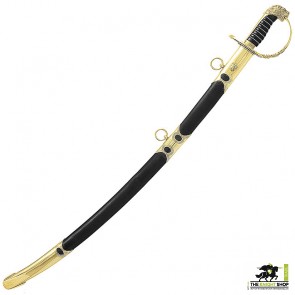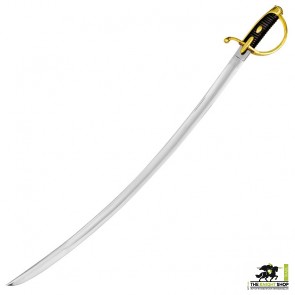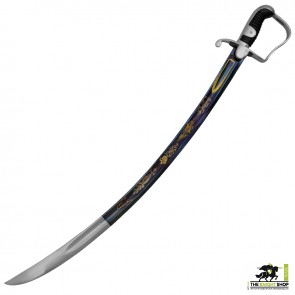Napoleonic Swords
-
British Royal Navy Officer's Sword - 1805 Pattern
Up until 1805 the Royal Navy did not have a regulation pattern sword. The sword that was introduced was modelled on the 1803 pattern infantry sabre that was previously carried by Navy and Marine officers. The 1805 pattern sword was used by Lord Horatio Nelson and he was no doubt armed with it at his most famous battle, The Battle of Trafalgar.
Learn More
After he was killed at the battle his sword was returned to England and is now on display in the Nelson Museum, Great Yarmouth, England. This sword was in constant use until it was replaced in 1827 by a newer model.
The polished blade has been forged from AISI 1065 High Carbon Steel and has been well tempered.
Total length: 95 cm
Blade length: 83 cm
Grip length: 10 cm
Weight: 0.905 kg
Blade thickness (base): 7.8 mm
Blade thickness (CoP): 5.3 mm
Blade width (base): 2.6 cm
Blade width (CoP): 2.2 cm
Point of Balance (PoB): 18 cm
Centre of Percussion (CoP): 25 cm
Blade: AISI 1065 High Carbon Steel
Edge: Blunt
Pommel: Peened
Scabbard: Leather, Wood, Brass
All dimensions are approximate and may vary from piece to piece. -
Household Cavalry Officer's Sword - 1814 Pattern
The Household Cavalry consists of the 2 most senior regiments in the British Army regiments, the Life Guards and the Blues and Royals. They were present at some of the British Army’s most notable battles, including Waterloo, where this sword would have seen action during the Charge of the Heavy Brigade.
Learn More
The styling of the Household Cavalry Officers Sword borrows much from the Prussian military ‘’Pallasch’’ swords. It features a tempered high-carbon steel blade inscribed with a “HAMBURGER & Co” makers mark to replicate an original. The ornate brass hilt encloses a leather wrapped wooden grip with twisted brass wire overlay. The wooden scabbard is covered with black leather and features an integrated brass sheath with brass hanging rings.
Total length: 110cm
Blade length: 96cm
Grip length: 9.5cm
Weight: 1550g
Blade thickness (base): 0.8cm
Blade width (base): 3.2cm
Point of Balance (PoB): 17cm
Blade: AISI 1065 High Carbon Steel
Edge: Blunt
Pommel: Peened
Scabbard: Leather, Wood, Brass
All dimensions are approximate and may vary from piece to piece. -
French Briquet Cutlass
This sword is very popular with people studying cutlass drills and was carried by most of the French Infantry throughout the Napoleonic Wars. It is also very popular for opening champagne bottles!
Learn More
The polished blade has been forged from EN9 steel and has been well tempered.
Total length: 74 cm
Blade length: 60 cm
Grip length: 10 cm
Weight: 1.012 kg
Blade thickness (base): 7.2 mm
Blade width (base): 3.4 cm
Point of Balance (PoB): 11 cm
Blade: High Carbon Steel
Edge: Blunt
Pommel: Peened
Scabbard: Leather, Wood, Brass
All dimensions are approximate and may vary from piece to piece. -
Prince of Wales’s 30th Light Dragoons Officer's Sabre
Our British Light Dragoons Sabre is a replica of the swords carried by the Prince of Wales’s 30th Light Dragoon Regiments from 1794-1796. A similar sword was carried by the Princes of Wales’s 10th Light Dragoon Regiments (still in existence as the 10th Royal Hussars). The 30th Light Dragoons Regiment only existed for a couple of years, making this sword both rare and collectable. The National Army Museum in London has one of the few surviving originals in its collection.
Learn More
Total length: 100cm
Blade length: 86cm
Handle length: 10cm
Blade thickness: 7mm - 3.7mm
Point of Balance (POB): 15cm
Weight: 1kg
Blade: AISI 1065 High Carbon Steel
Edge: Blunt
Pommel: Integrated
Scabbard: Leather, Wood, Steel
All dimensions are approximate and may vary from piece to piece. -
British Light Cavalry Sabre - 1796 Pattern
Light Cavalry refers to lightly armed troops whose major tasks were reconnaissance, screening, skirmishing, raiding, and communications. They used to carry a light sword like this. This Light Cavalry sword found its use mainly around 1796. It has a curved blade, which makes it easy to be carried around the waist while riding on the horse.
Learn More
Total length: 96 cm
Blade length: 83 cm
Grip length: 9.5 cm
Weight: 1.078 kg
Blade thickness (base): 6 mm
Blade width (base): 3.4 cm
Point of Balance (PoB): 22 cm
Blade: AISI 1065 High Carbon Steel
Edge: Blunt
Pommel: Peened
Scabbard: Steel
All dimensions are approximate and may vary from piece to piece. -
British Light Cavalry Sabre - 1796 Pattern
Famed for its use by Britain’s Light Dragoons and Hussars during the Peninsular War and Waterloo, this sword was also supplied to the Prussian Cavalry in great numbers and even found favour in the USA.
Learn More
This design was suggested for British service by cavalry officer John Gaspard Le Marchant, who believed cavalry swords should be light and have a curved, slashing blade. The long curved blade has been forged from AISI 1065 High Carbon Steel and has been well tempered.
Replacement scabbard available separately
Total length: 96 cm
Blade length: 83 cm
Grip length: 9.5 cm
Weight: 1.078 kg
Blade thickness (base): 6 mm
Blade width (base): 3.4 cm
Point of Balance (PoB): 22 cm
Blade: AISI 1065 High Carbon Steel
Edge: Blunt
Pommel: Peened
Scabbard: Steel
All dimensions are approximate and may vary from piece to piece. -
95th Rifles Regimental Sabre - 1803 Pattern
This sword is a must for fans of Bernard Cornwell’s “Sharpe”! Army regulations specified that the swords for officers of the Rifle Corps was to be ‘a sabre similar to the Light Cavalry’. The 1796 sabre was clearly too long and the result was the 1803 Pattern Regimental Sabre.
Learn More
This sword is based on an original in the National Army Museum. The original blade has faded evidence of complex etching, this has not been replicated on our tempered AISI 1065 high carbon steel blade. The brass, nickel-plated hilt features a wood grip wrapped in black leather with a steel wire overlay. It is also etched with the number 95, alluding to the 95th Rifles Regiment. The pure buff hardened leather scabbard has steel fittings and suspension rings. It is based on a watercolour print from 1812 showing an officer of the 95th wearing a scabbard of this configuration.
Total length: 94cm
Blade length: 80cm
Grip length: 9.5 cm
Weight: 1176g
Blade thickness (base): 0.5cm
Blade width (base): 3cm
Point of Balance (PoB): 18 cm
Blade: AISI 1065 High Carbon Steel
Edge: Blunt
Pommel: Nut
Scabbard: Leather, Steel
All dimensions are approximate and may vary from piece to piece. -
British Flank Infantry Officer's Sabre - 1803 Pattern
This sabre was introduced in 1803 and proved a popular replacement for the 1796 Infantry Sword. It was readily adopted by Light Infantry and Rifle Officers who were much more likely to skirmish with the enemy than their Line Infantry counterparts. The design proved popular and it was adopted by flank companies of the Royal Marines and some Royal Navy officers as well.
Learn More
The polished blade has been forged from AISI 1065 High Carbon Steel and has been well tempered.
Total length: 94.5 cm
Blade length: 82 cm
Grip length: 8 cm
Weight: 1.102 kg
Blade thickness (base): 7.5 mm
Blade width (base): 3 cm
Point of Balance (PoB): 20 cm
Blade: AISI 1065 High Carbon Steel
Edge: Blunt
Pommel: Peened
Scabbard: Leather, Wood, Brass
All dimensions are approximate and may vary from piece to piece. -
Napoleonic AN XI Light Cavalry Sabre
This replica saber of the AN XI has an unsharpened blade of tempered high carbon steel. The spine of the blade bears the recreated 1813 signature of the famed Klingenthal sword manufactory in Alsace. The hilt is of brass and the grip is wrapped in tight black leather. The scabbard is of steel with two integrated steel hanging rings.
Learn More
Total length: 100cm
Blade length: 86.5cm
Grip length: 10cm
Weight: 1068g
Blade thickness (base): 0.7cm
Blade width (base): 3cm
Point of Balance (PoB): 19.5cm
Blade: EN9 High Carbon Steel
Edge: Blunt
Pommel: Peened
Scabbard: Leather, Wood, Steel
All dimensions are approximate and may vary from piece to piece. -
British Light Cavalry Sabre - 1796 Pattern - Blue Etching
This British 1796 Cavalry Saber has been beautifully embellished with a blued and gilt treatment at the base of the blade which was a popular adornment for military officers to dignify their swords above the standard issue to match their rank and station. The tempered blade is forged from 1055 high carbon steel and the hilt is steel with a wood and leather grip. The blade is peened over the pommel to solidly fit the blade into the hilt. The sword is matched with a steel scabbard completed with steel hanging rings.
Learn More
The British pattern 1796 Cavalry Saber was used by the Hussars, Light Dragoons and Kings German Legion Light Cavalry of the Napoleonic Era. The sword was designed by John Gaspard Le Marchant, one of the finest cavalrymen of his day who bemoaned the long and heavy swords then in use by his expeditionary force during their experience in France during its Revolutionary War. His design became one of the most lauded of cavalry sabers.Unlike its predecessor, the 1796 saber had a more pronounced curve, making slashing easier and deadly. The saber, somewhat unusually among its peers, also widened at its tip, putting weight and heft at the tip making its slashes more vicious.
Total length: 96 cm
Blade length: 83 cm
Grip length: 9.5 cm
Weight: 1.078 kg
Blade thickness (base): 6 mm
Blade width (base): 3.4 cm
Point of Balance (PoB): 22 cm
Blade: AISI 1065 High Carbon Steel
Edge: Blunt
Pommel: Peened
Scabbard: Steel
All dimensions are approximate and may vary from piece to piece.




